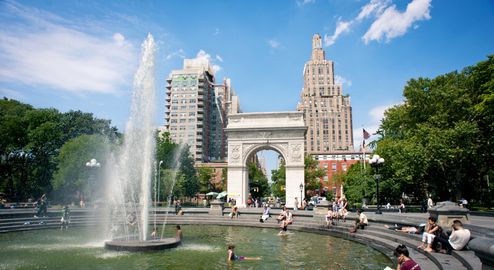

The most famous public park in New York, obviously, is Central Park. However, although it has not been statistically proven, the most crowded in terms of human density per square meter, is probably Washington Square Park, especially on a sunny Saturday afternoon. The park covers 39,500 square meters and is bordered by Waverly Place at the north, Washington Square East, Washington Square West and West 4th Street at the south.
In the beginning, as with most of Manhattan, the territory that today constitutes Washington Square Park was settled by Native Americans. It was marshy and uncultivable at first. The Dutch settlers later gave this land to the slaves that they had set free in order to use it as a buffer zone between New Amsterdam and the Indian settlements up north. Towards the end of the 18th century, when the British had already taken possession of Manhattan, they created a public burial ground for unknown or sick people. The cemetery stopped functioning in 1825 and today it is estimated that over 25,000 corpses still lie deep under the park.
In the middle of 19th century the city bought the land from private owners and created the Washington Military Parade Ground for the training of volunteer militias. Later the military ground was transformed into a city park with benches, walking paths and flowerbeds. The oldest buildings around the park are the row houses built in Greek revival style, which are found on the north side.
In 1889, to commemorate the centennial of George Washington's inauguration as first president of America, the city erected a 23-meter-high arch on the north side of the park, where Fifth Avenue ends. It was created in Tuckahoe marble by architect Stanford White, who had modeled it after the Arc de Triomphe in Paris. It is decorated with stars, military motifs, figures of the goddess Victory, the American bald eagle and on the top part called the attic, if we look closely, we will be able to read the following inscription: Let us raise a standard to which the wise and the honest can repair. The event is in the hand of God. - Washington. On the northern side there is a sculpture of Washington himself, while he was still Commander-in-Chief of the American Revolutionary Army. On the western part there is a sculpture of Washington as president accompanied by the personifications of Fame and Valor.
The park's main attraction, however, is the central fountain and pool, which were built in 1934 during a modernization and embellishment project. The project, initiated by Parks Commissioner Robert Moses, also intended to have Fifth Avenue run through the park and connect to what today is Thompson Street. However, the city's activists, including Washington Square Park West resident Eleanor Roosevelt, widow of former US President Franklin D. Roosevelt, put up a big fight and eventually Moses was forced to back down.
The fountain has been the center of attraction since the end of World War II when folksingers would gather around and give free concerts. But these performances were not always considered entertainment - many local residents were actually very annoyed and complained to the authorities. In 1947 the authorities required all singers, dancers and musicians to apply for a permit before outdoor public performances. In the 50s Washington Square Park was a mecca for the Beat Generation, in the 60s and 70s it was a hippie hangout and in the 80s a drug dealer's haven.
In 2007 the park was slightly redesigned and greatly cleaned up. The graffiti that marred the Arch was removed, old trees were cut down, new benches were put up and the fountain realigned with the arch. But the main features have remained: the children's playgrounds, the gardens, the statue to Giuseppe Garibaldi, the chess tables, the dog runs and the most amazing feature of all, the 335-year-old Hangman's Elm at the northwest corner of the park, Manhattan's oldest tree.
Today Washington Square Park combines many moods and attitudes. Being surrounded by New York University buildings, it is definitely pervaded with a studious air. Being in Greenwich Village it also shines with bohemian glee and creativity. And being at the end of Fifth Avenue it introduces an element of sophistication and worldliness. It is everything. It is a perfect representative of the city itself.